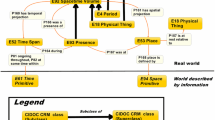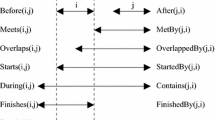Abstract
This paper describes an approach for automatically combining geospatial and temporal ontologies such that a geospatial domain can be analyzed over multiple temporal granularities. Terms from a geospatial ontology are combined with terms from a temporal ontology to form cross products that provide an integrated spatiotemporal framework. This framework is multi-granular, highlighting elements from the geospatial ontology at different domain times. We show how pairs of ontologies represented in Protégé can be used as the input for deriving cross products and how the results of this technique can be used as a basis for querying and retrieving new perspectives on geospatial domains. Visualizations of cross product spaces highlight the geospatial–temporal combinations of terms as well as the different relations that link these terms and improve the understanding of the structure of the spatiotemporal framework. Methods for filtering terms from the cross products are also investigated in order to prune the resulting frameworks and remove irrelevant or unnecessary terms.


















Similar content being viewed by others
References
Agarwal P (2005) Ontological considerations in GIScience. Int J Geogr Inf Sci 19(5):501–536. doi:10.1080/13658810500032321
Brachman R (1983) What is-a is and isn’t: an analysis of taxonomic links in semantic networks. IEEE Comput 16(10):30–36
Corbett D (2003) Comparing and merging ontologies: a concept type hierarchy approach. In: Proceedings of the 14th International Symposium on Methodologies for Intelligent Systems, Maebashi City, Japan, pp 75–82
Cruz I, Sunna W, Chaudhry A (2004) Ontology alignment for real-world applications. In: Proceedings of The National Conference on Digital Government Research, pp 393–394
Duckham M, Worboys M (2007) Automated geographic information fusion and ontology alignment. In: Belussi A, Catania B, Clementini E, Ferrari E (eds) Modelling and management of geographical data over distributed architectures. Springer, Berlin (in press)
Egenhofer MJ (1993) A model for detailed binary topological relationships. Geomatica (Ottawa, ON), Canadian Institute of Geomatics 47:(3–4):261–273
Fonseca F, Camara G, Monteriro A (2006) A framework for measuring the interoperability of geo-ontologies. Spat Cogn Comput 6(4):307–329
Frank A (2007) Wayfinding for public transportation users as navigation in a product of graphs. VGI Sonderheft 95(2):195–200
Grenon P, Smith B (2004) SNAP and SPAN: towards dynamic spatial ontology. Spat Cogn Comput 4(1):69–104. doi:10.1207/s15427633scc0401_5
Hamilton HJ, Hilderman RJ, Cerone N (1996) Attribute-oriented induction using domain generalization graphs. In: Proceedings of the Eighth IEEE International Conference on Tools with Articial Intelligence (ICTAI’96), Toulouse, France, pp 246–253
Han J (1994) Towards efficient induction mechanism in database systems. Theor Comp Sci (Special Issue on Formal Methods in Databases on Software Engineering) 133(2):361–385
Han J, Cai Y, Cerone N (1992) Knowledge discovery in databases: an attribute oriented approach. In: Proceedings of the 18th International Conference on Very Large Databases, Vancouver, pp 547–559
Harvey F, Kuhn W, Pundt H, Bishr Y, Riedemann C (1999) Semantic interoperability: a central issue for sharing geographic information. Ann Reg Sci Spec Issue Geo-spatial Data Shar Stand 33:213–232
Hilderman RJ, Li L, Hamilton HJ (1997) Data visualization in the DB-discover system. In: Proceedings of ICTAI, pp 474–477
Hilderman RJ, Hamilton HJ, Kowalchuk RJ, Cerone N (1997) Parallel knowledge discovery using domain generalization graphs. In: Proceedings of Principles of Data Mining and Knowledge Discovery, pp 25–35
Hill DP, Blake JA, Richardson JE, Ringwald M (2002) Extension and integration of the gene ontology (GO): combining GO vocabularies with external vocabularies. Genome Res 12(12):1982–1991. doi:10.1101/gr.580102
Klein M (2001) Combining and relating ontologies: an analysis of problems and solutions. Workshop on Ontologies and Information Sharing, IJCAI
Kohler J, Lange M, Hofestadt R, Schulze-Kremer S (2000) Logical and semantic database integration. IEEE International Symposium on Bio-Informatics and Biomedical Engineering (BIBE’00), pp 77
Lutz M, Klien E (2006) Ontology-based retrieval of geographic information. Int J Geogr Inf Sci 20(3):233–260. doi:10.1080/13658810500287107
Niles I, Pease A (2003) Linking lexicons and ontologies: mapping wordnet to the suggested upper merged ontology. In: Proceedings of the 2003 International Conference on Information and Knowledge Engineering (IKE ’03), Las Vegas, Nevada
Pang W, Hilderman RJ, Hamilton HJ, Goodwin SD (1996) Data mining with concept generalization digraphs. Proceedings of the 9th International Florida Artificial Intelligence Research Symposium (FLAIRS'96), Key West, FL, pp 390–394
Riedemann C, Kuhn W (1999) What are sports grounds? Or: why semantics requires interoperability. International Conference on Interoperating Geographic Information Systems, LNCS 1580, Zurich, pp 217–229
Smith B, Köhler J, Kumar A (2004) On the application of formal principles to life science data: a case study in the gene ontology. Proceedings of Data Integration in the Life Sciences (DILS) 2004, Lecture Notes in Bioinformatics, 2994, Springer, pp 79–94
Winston ME, Chaffin R, Herrmann DJ (1987) A taxonomy of part-whole relations. Cogn Sci 11(4):417–444
Zhou N (2003) A study on automatic ontology mapping of categorical information. Proceedings of the 2003 annual national conference on Digital government research, Boston, MA, pp 1–4.
Acknowledgments
Kathleen Stewart Hornsby’s research is supported in part by the US Department of Defense under grant numbers HM1582-05-1-2039, HM1582-08-1-2001 and HM1582-08-1-0013.
Author information
Authors and Affiliations
Corresponding author
Rights and permissions
About this article
Cite this article
Hornsby, K.S., Joshi, K. Combining ontologies to automatically generate temporal perspectives of geospatial domains. Geoinformatica 14, 481–505 (2010). https://doi.org/10.1007/s10707-009-0088-1
Received:
Revised:
Accepted:
Published:
Issue Date:
DOI: https://doi.org/10.1007/s10707-009-0088-1




